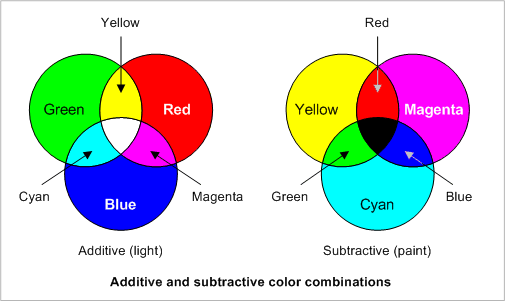return to homepage
return to 2006
An Art Experiment
by Miles Mathis
After
several weeks of politics, it is time to return to art and science.† Here is an art experiment you can do with
me.†
††††† I have noticed a slight compartmentalization in my brain,
concerning the way my eyes see color.† I
have not read of this particular specialization in any of my readings of brain
function, so I thought I would let my readers supply me with the data to extend
this finding beyond my own eyes.
†††††† In order to do this experiment, you need to be outside on a
sunny day, in direct sunlight.† You need
some brightly colored objects, with colors that are as near to the primaries as
possible.† The paint-mixing primaries,
not the photoshop primaries.††† Meaning,
red, blue, yellow.†† Green also works
well, so actually we can include the photoshop primaries, if we mean RBG and
not CMYK.††† I discovered this
phenomenon while lying on a brightly colored beach towel.†† For me it works best with blue and yellow.
††††††† Here is what I discovered.†
My left eye sees a richer blue and my right eye sees a richer
yellow.†† There would appear to be more
or better receptors for yellow in one eye, and for blue in the other.†† This makes the same red look more orange in
my right eye and more purple in my left eye.††
And it makes the same green look yellower in my right eye and bluer in
my left eye.†
††††††† The difference is very slight, and I believe it would take
an artist to notice it.†† I didnít
notice it until I was older, which could mean one of two things.† Either I wasnít as observant when I was
younger, or the specialization hadnít yet become extreme enough to notice.†
††††††† I am left-handed and left-eye dominant.†† For this reason, I might expect that right-handers
would see blue better with the right eye.††
But we will have to see.†† These
expectations donít always bear themselves out.†
I have another interesting
theory.† Since the wiring is crossed in
the brain, my right brain is receiving the information from my left hand and
left visual hemisphere.† This would mean
that the visual information in my right brain is saturated bluer; and my left-brain,
yellower.†† Now, the right brain
specializes in many of the functions of art and creativity.††† Hence the famous book Drawing on the
Right Side of the Brain.†† This is
true both for left-handers and right-handers.††
It is thought that left-handers may have a more direct link to the right
brain, but their brain maps are not reversed.††
The brain of a left-hander is, in most major ways, set up like a right-hander.†† Its chirality is the same.† Other organization may vary, such as
left/right links, or degree of asymmetry, but the major division is equivalent.†
†††††††† This means that, in some sense, my entire creative process
is saturated blue.† This could explain
why I always correct my photographs toward the blue, why I use little yellow on
my palette, why my entire artistic oeuvre is more blue than yellow, and
even why I like Picassoís Blue Period.††
†††††††† If we find that my experience is like that of other left-handers,
it could mean that color preference is tied to handedness.† Perhaps all lefties skew their paintings
toward blue and all righties toward yellow.††
Leonardo, a lefty, certainly tends to confirm my hypothesis.†† As does Picasso.† Munch was left-handed.†
And Titian was right-handed.†† We
would expect Jamie Wyeth to be right-handed, as he is, and I believe I remember
that Dan Gerhartz is right-handed.†† Was
Reynolds a righty and Gainsborough a lefty?††
I donít know, but it is an interesting question.†††
†††††††† This would also have market consequences.† If righties prefer warmer paintings, and
righties make up 85 to 90% of the population, then this would tend to make it
difficult for lefties.†† Only the fact that
lefties tend to be more interested in art to start with begins to even it out a
bit.††† Men are also more likely to be
lefties, by at least 2 percentage points, but I am not sure that helps us.†† I would have to show that men shop for art
more often than women and I cannot do that.†
††††††††† It is not just color that differentiates art by left-handers
and right-handers.† Lefties may, in many
ways, look at the face as a reversed image, compared to righties.† We all know that this would make a huge difference,
if it were true.†† A face reversed is
not the same face.† It doesnít have the
same expression or the same emotional content.†
This has been proven beyond a doubt by manipulated photographs and false
composites.††† You can see it clearly
just by taking scans of your paintings into photoshop and reversing them.†† The whole tone of the painting may change,
especially if it contains a face.†
††††††† Could it be that a righty sees one of my paintings like
that?†† That he or she feels what I feel
when I see the reversed image, rather than what I feel when I look at the
correct image?†† I donít know.† It is possible, and it might explain a
lot.†
†††††††† Maybe I will post all my scans in reverse, with a yellow
cast, and see if my sales go up.
If this paper was useful to you in any way, please consider donating a dollar (or more) to the SAVE THE ARTISTS FOUNDATION. This will allow me to continue writing these "unpublishable" things. Don't be confused by paying Melisa Smith--that is just one of my many noms de plume. If you are a Paypal user, there is no fee; so it might be worth your while to become one. Otherwise they will rob us 33 cents for each transaction.